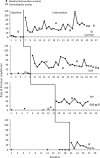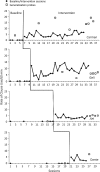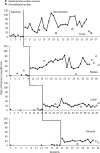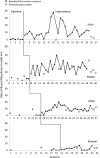Effects of a Conversation-Based Intervention on the Linguistic Skills of Children With Motor Speech Disorders Who Use Augmentative and Alternative Communication
- PMID: 28672283
- PMCID: PMC5831090
- DOI: 10.1044/2016_JSLHR-L-15-0246
Effects of a Conversation-Based Intervention on the Linguistic Skills of Children With Motor Speech Disorders Who Use Augmentative and Alternative Communication
Abstract
Purpose: This study was conducted to evaluate the effects of a conversation-based intervention on the expressive vocabulary and grammatical skills of children with severe motor speech disorders and expressive language delay who use augmentative and alternative communication.
Method: Eight children aged from 8 to 13 years participated in the study. After a baseline period, a conversation-based intervention was provided for each participant, in which they were supported to learn and use linguistic structures essential for the formation of clauses and the grammaticalization of their utterances, such as pronouns, verbs, and bound morphemes, in the context of personally meaningful and scaffolded conversations with trained clinicians. The conversations were videotaped, transcribed, and analyzed using the Systematic Analysis of Language Transcripts (SALT; Miller & Chapman, 1991).
Results: Results indicate that participants showed improvements in their use of spontaneous clauses, and a greater use of pronouns, verbs, and bound morphemes. These improvements were sustained and generalized to conversations with familiar partners.
Conclusion: The results demonstrate the positive effects of the conversation-based intervention for improving the expressive vocabulary and grammatical skills of children with severe motor speech disorders and expressive language delay who use augmentative and alternative communication. Clinical and theoretical implications of conversation-based interventions are discussed and future research needs are identified.
Supplemental materials: https://doi.org/10.23641/asha.5150113.
Figures








Similar articles
-
Conversation-based intervention for adolescents using augmentative and alternative communication.Augment Altern Commun. 2018 Sep;34(3):180-193. doi: 10.1080/07434618.2018.1490926. Epub 2018 Jul 25. Augment Altern Commun. 2018. PMID: 30043650 Free PMC article.
-
Early Sentence Productions of 3- and 4-Year-Old Children Who Use Augmentative and Alternative Communication.J Speech Lang Hear Res. 2017 Jul 12;60(7):1930-1945. doi: 10.1044/2017_JSLHR-L-15-0408. J Speech Lang Hear Res. 2017. PMID: 28614575 Free PMC article.
-
Recast type, repair, and acquisition in AAC mediated interaction.J Child Lang. 2020 Jan;47(1):250-264. doi: 10.1017/S0305000919000436. Epub 2019 Sep 16. J Child Lang. 2020. PMID: 31524119
-
Communication interventions for autism spectrum disorder in minimally verbal children.Cochrane Database Syst Rev. 2018 Nov 5;11(11):CD012324. doi: 10.1002/14651858.CD012324.pub2. Cochrane Database Syst Rev. 2018. PMID: 30395694 Free PMC article.
-
Assessing language skills in adult key word signers with intellectual disabilities: Insights from sign linguistics.Res Dev Disabil. 2017 Mar;62:174-183. doi: 10.1016/j.ridd.2017.01.017. Epub 2017 Feb 9. Res Dev Disabil. 2017. PMID: 28182997 Review.
Cited by
-
Comparison of Preschooler Verbal and Graphic Symbol Production Across Different Syntactic Structures.Front Psychol. 2021 Nov 25;12:702652. doi: 10.3389/fpsyg.2021.702652. eCollection 2021. Front Psychol. 2021. PMID: 34925122 Free PMC article.
-
The emergence of clause construction in children who use speech generating devices.Augment Altern Commun. 2019 Jun;35(2):109-119. doi: 10.1080/07434618.2019.1584642. Epub 2019 May 9. Augment Altern Commun. 2019. PMID: 31070060 Free PMC article.
-
Sensitivity to Communication Partners During Naturalistic AAC Conversations in Cantonese Chinese.Front Psychol. 2021 Aug 18;12:686657. doi: 10.3389/fpsyg.2021.686657. eCollection 2021. Front Psychol. 2021. PMID: 34489796 Free PMC article.
-
Conversation-based intervention for adolescents using augmentative and alternative communication.Augment Altern Commun. 2018 Sep;34(3):180-193. doi: 10.1080/07434618.2018.1490926. Epub 2018 Jul 25. Augment Altern Commun. 2018. PMID: 30043650 Free PMC article.
-
Dyadic Conversation between Mandarin-Chinese-Speaking Healthy Older Adults: From Analyses of Conversation Turns and Speaking Roles.Behav Sci (Basel). 2023 Feb 5;13(2):134. doi: 10.3390/bs13020134. Behav Sci (Basel). 2023. PMID: 36829363 Free PMC article.
References
-
- Adelman J., Brown G., & Quesada J. (2006). Contextual diversity, not word frequency, determines word-naming and lexical decision times. Psychological Science, 17, 814–823. - PubMed
-
- Binger C., & Light J. (2008). The morphology and syntax of individuals who use AAC: Research review and implications for effective practice. Augmentative and Alternative Communication, 24, 123–138. - PubMed
-
- Binger C., Maguire-Marshall M., & Kent-Walsh J. (2011). Using aided AAC models, recasts, and contrastive targets to teach grammatical morphemes to children who use AAC. Journal of Speech, Language, and Hearing Research, 54, 160–176. - PubMed
-
- Bloom P. (2000). How children learn the meanings of words (Vol. 377). Cambridge, MA: MIT press.
-
- Boenisch J., & Soto G. (2015). The oral core vocabulary of typically developing English-speaking school-aged children: Implications for AAC practice. Augmentative and Alternative Communication, 31, 77–84. - PubMed
Publication types
MeSH terms
Grants and funding
LinkOut - more resources
Full Text Sources
Other Literature Sources
Medical

